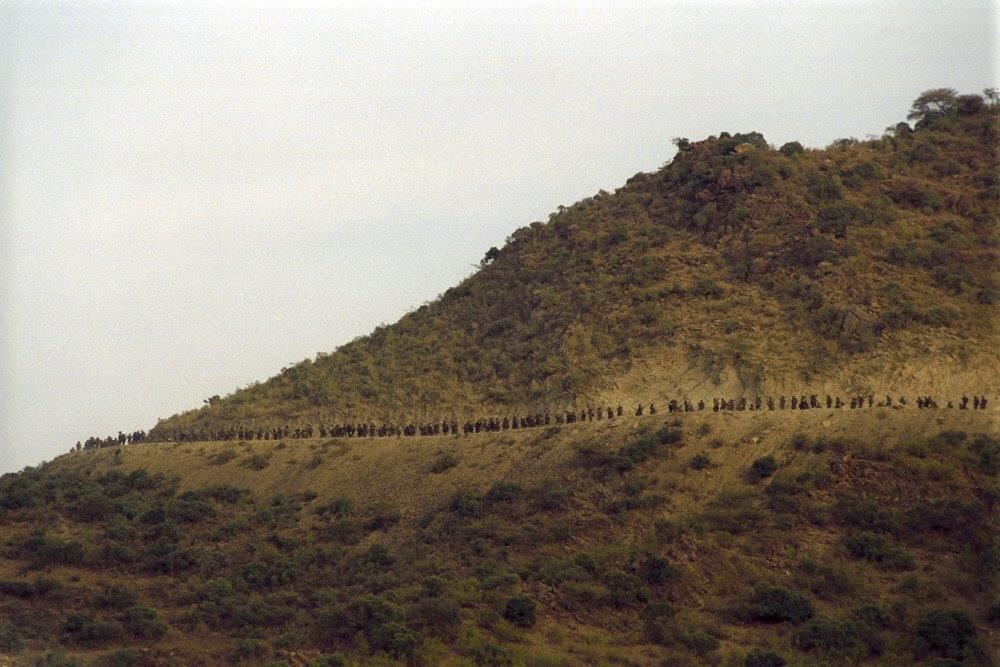Photo Petterik Wiggers
By Fred Harter of the Humanitarian
As a rebel soldier, 24-year-old Danayit fought in some of the fiercest battles of the recent civil war in Ethiopia’s northern Tigray region, often spending days marching through the mountains without food and losing dozens of friends on the front line.
Eventually, a piece of shrapnel from a shell struck her in the head as she battled against the federal military and its Eritrean allies. Much of the metal is still in her skull and gives her crushing headaches in bright light or when she hears loud noises.
She sustained her injury days before negotiators huddled in South Africa’s capital, Pretoria, reached a ceasefire agreement in November 2022, ending the devastating conflict. But a year later, Danayit says she has received no help, despite official promises of support.
“They said job opportunities will be created [for former fighters], but nothing has happened,” she told The New Humanitarian. Instead, she subsists on a salary of $35 a month earned as a cleaner at a war-damaged factory in the Tigray town of Adigrat.
“I feel like I’ve been forgotten by the authorities and treated as a disposable piece of chewing gum,” said Danayit, who gave only her first name. “Most days, I go to sleep with hardly anything to eat.”
Across Tigray, there are 270,000 young men and women like Danayit – members of the self-styled Tigray Defence Forces (TDF), the rebel army that for two years fought the federal military – who are still waiting to be demobilised and reintegrated into society.
Tens of thousands more combatants from other parts of Ethiopia are also due to be disarmed under a nationwide process. Some, from the Afar and Amhara regions bordering Tigray, mobilised to beat back TDF incursions. Others are from long-running insurgencies in the states of Oromia, Gambela, and Benishangul-Gumuz.
Involving an initial total of at least 371,971 fighters, this demobilisation process will be the largest in the world and is currently expected to cost $849 million over a four to five year period.
The government has created a National Rehabilitation Commission to oversee the process. It has drawn up a framework to guide it and enlisted the help of the UN, but the process itself has not started yet – mainly because there is no money to fund it.
The Ethiopian government plans to meet around 15% of the cost, with donors expected to pick up the rest of the bill, according to a copy of the demobilisation framework seen by The New Humanitarian. But so far, not a single dollar has been received.
“Everything is ready. We just need the funds,” said a senior official from a development partner, who requested anonymity so they could speak freely.
Threat to a fragile peace
As the process drags on, observers fear the disgruntlement of hundreds of thousands of former fighters – many still with ready access to small arms – could destabilise Tigray’s fragile peace. Most have spent months cooped up in informal camps, waiting to be demobilised.
“It is a huge problem,” noted a Western diplomat, who also spoke on condition of anonymity. “Right now, we have fighters who need to be demobilised who are camping in schools and other places, without sufficient housing or food or anything.”
Former TDF fighters say conditions in these camps are poor. Many are forced to sleep in the open, with no protection against the elements, and there is so little to eat that several fighters told The New Humanitarian they are resorting to begging for food.
“During my stay in the demobilisation camps, flour and cooking oil were only provided to us once,” said Danayit.
There are also concerns that the Tigray People’s Liberation Front (TPLF), the party that led the rebels, is not fully committed to disarming and secretly retains much of its arsenal.
Under the terms of an implementation accord signed shortly after the ceasefire was reached last year, the Tigray rebels agreed they would hand over their heavy weapons concurrently with the withdrawal of “foreign” and non-federal forces from Tigray – a reference to the presence of Eritrean and Amhara troops in the region.
This condition has not been met since forces from Amhara still occupy western and southern Tigray – lands they claim as their own – while Eritrean troops remain in several areas along the northern border.
The implementation deal also said a committee would draw up a plan and timeline for handing over light weapons. But so far there has been no formal handover of small arms, and young men carrying AK-47s are still a common sight in Tigray.
Nonetheless, a 10-man African Union (AU) team set up to monitor and verify the process – and headed by a two-star Kenyan general, Stephen Radina – says things are going smoothly.
Yet the monitoring mission has been hamstrung by poor organisation and by its small size, with the monitors struggling to cover the whole region, according to diplomatic and AU sources. As a result, few observers trust the monitoring mission’s reports.
Donors have offered funding to scale the mission up to around 70 members, but both the federal government and the TPLF refused, partly, according to a Western security source, because they wanted to minimise the role of the international community.
“They don’t want too much outside interference, which is always a concern of the Ethiopians, so they agreed to a small, slim mission, enough to be accepted,” the source said.
Go-slow disarmament
In January, the Tigray forces handed over several artillery pieces and other heavy weapons at a televised ceremony to the federal military. However, these items are believed to represent only a small fraction of the former rebels’ arsenal, with the rest still hidden in mountain caches.
“The TDF hasn’t disarmed yet because they want the contested territories back first, and they still fear Eritrea,” one Western diplomat said. No one knows how many small arms are in the region.
“We are dealing with a very urgent task. These people are trained for war. Leaving them unattended has serious, serious risks, and I think everyone understands this.”
Other analysts, however, are more optimistic, and overall few doubt the parties’ commitment to avoiding a renewal of the conflict, which killed hundreds of thousands of people.
“[The AU’s monitoring mission], even if it’s quite small, is supporting accountability of the conflict parties and at least giving some visibility to the process”, said a security source. “Without it, there would be nothing.”
Teshome Toga, who heads the new National Rehabilitation Commission charged with demobilising and reintegrating former fighters once they’ve been disarmed, admitted the process has been slow, saying this was partly “because we are starting from scratch”.
Most rooms in his commission’s newly renovated headquarters in Addis Ababa lack office furniture and half of its staff positions are yet to be filled. Yet Teshome insisted that a detailed framework for demobilising the fighters and returning them to civilian life has been prepared, in accordance with international principles and based on lessons from demobilisation programmes in Colombia, Nigeria, and South Sudan.
It involves, he said, registering the fighters at reception centres, where they will be offered medical and psychological support over several months. They will then be supported by a financial “reinsertion” package of small monthly payments worth several hundred dollars. Afterwards, they will be helped to find jobs, set up businesses, or return to education, Teshome added.
‘No other alternative: We need peace’
The process was supposed to start in September, but it is not running yet because of the lack of funding, even though an initial sum of just $150 million is needed.
“We have clearly presented our needs, and I hope and expect the resources will come,” Teshome told The New Humanitarian. “Everyone knows the sensitivity; we are dealing with a very urgent task. These people are trained for war. Leaving them unattended has serious, serious risks, and I think everyone understands this.”
Teshome acknowledged that conditions are poor for fighters in camps awaiting demobilisation and said the process is “vital” to implementing the ceasefire: “We are committed because we have no other alternative: We need peace.”
Despite the slow progress, the senior official from one of Ethiopia’s development partners pointed out that demobilisation processes are usually drawn out and plagued by funding gaps.
“I think it’s really important to stress that Ethiopia has adopted international DDR standards, which is very good,” they said, using the common acronym for disarmament, demobilisation, and rehabilitation.
The inclusion of former fighters from other internal conflicts has muddied the waters further. Several of these conflicts are ongoing, such as the Oromo Liberation Army’s long-running insurgency in Oromia and the new rebellion in the Amhara region.
None are party to the Pretoria ceasefire between Tigray and the federal government, although the national demobilisation plan is based on the principles of this deal. “This makes things complicated and is contributing to the delay,” said the security source.
‘Nothing has been solved’
As the wait continues, the Tigray authorities are coming under increasing pressure from its veterans, who have staged protests in Mekelle, the regional capital, demanding more support.
In July, the region said it had so far demobilised over 50,000 former fighters. Most of these appear to have been wounded veterans and few received proper support, although the regional authorities said they had been given three months’ worth of food.
They included Danayit, who said she was discharged in July “with only a single piece of paper. I wasn’t given anything else”.
“There has been little to no help given to us,” Mihretab, another fighter discharged in July, told the New Humanitarian, again preferring to give only one name.
The former fighters described being cantoned for months with 8,000 others in camps pitched in arid rural areas.
They said they slept in the open with plastic tarpaulins as mattresses, lacked clean drinking water, and subsisted on a daily ration of stale bread, supplemented by handouts from local villagers – despite the widespread hunger worsened by a UN and US food aid freeze imposed in March following the discovery of major thefts of relief grain by officials.
“I feel like we’ve been forgotten,” Mihretab said. “Nothing has been solved. It’s hard to accept that hundreds of thousands have been martyred for this.”
This article was first published by the Humanitarian: https://www.thenewhumanitarian.org/news-feature/2023/11/02/ethiopias-unfinished-peace-deal-leaves-ex-fighters-in-limbo

